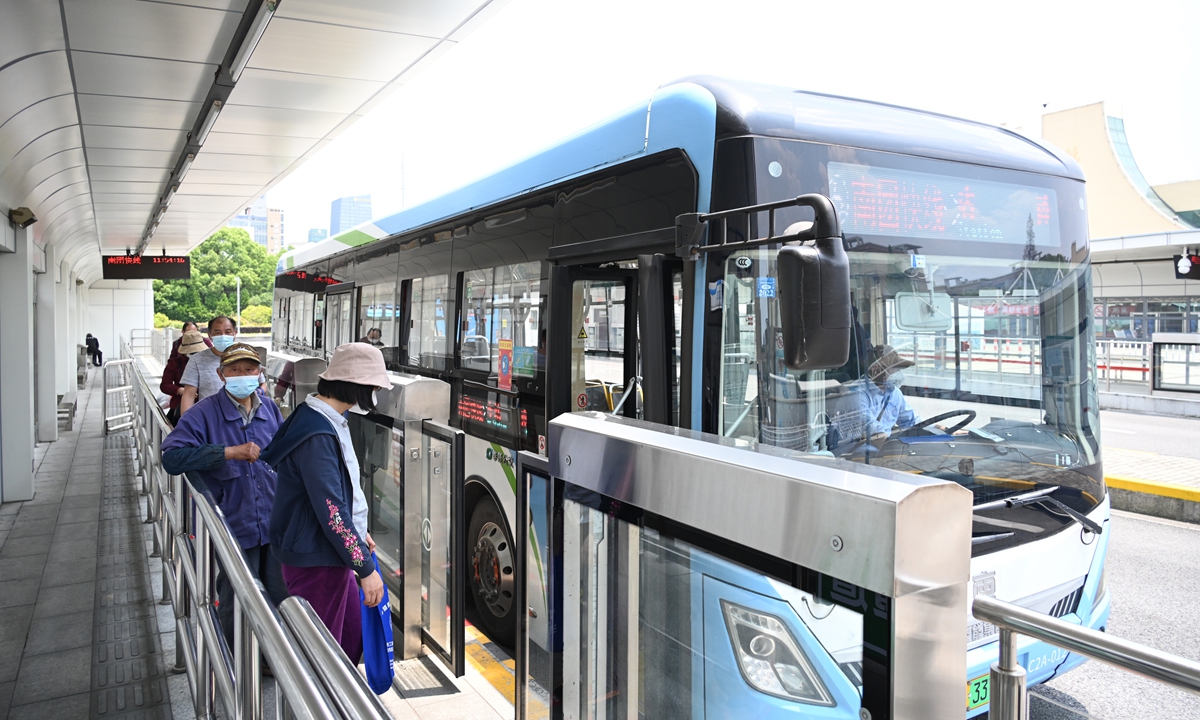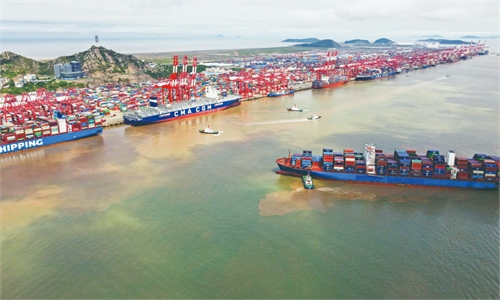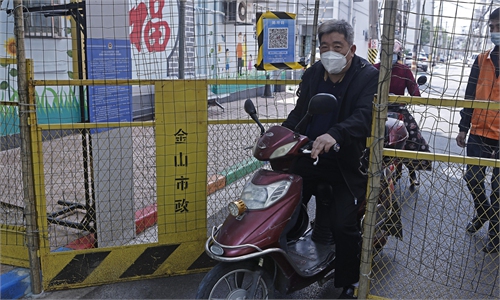
People wait in line to get on a bus. Bus service partly resumed in Shanghai on May 16. Photo: thepaper.cn
When many countries around the world have stopped bothering to curb the spread of the Omicron variant, it is convenient to conclude that living with the virus is a sustainable approach. At least WHO Director General Dr Tedros Adhanom Ghebreyesus, would be tempted to agree. On Tuesday Dr Tedros said his organization did not think China's COVID prevention measures were "sustainable considering the behavior of the virus." However, there are serious miscalculations.'Tsunami' of infections under Dr Tedros's scenario
The so-called "sustainable" live-with-the-virus approach may lead to a "Tsunami" of infections, one researcher says. The peer reviewed study by Shanghai's Fudan University, published in the Nature journal, said without large-scale testing and timely quarantines, the spread of Omicron could lead to 112.2 million symptomatic cases, 5.1 million hospital admissions and 1.6 million deaths in China, with the major wave occurring between May and July.
An unneglectable factor is China's huge population base of the elderly who would otherwise suffer disproportionately from the Omicron variant. Research shows that some 92 million people in China over the age of 60 are at risk of serious illness and death if the COVID prevention and control measures are lifted. Without these necessary measures, an uncontrolled spread of COVID-19 could lead to overwhelmed hospitals and high fatality rates, as was seen during the outbreak of the Omicron variant from mid-February to April 2022 in Hong Kong.
The 1.6 million ensuing deaths under this scenario would be even more than the reported death toll in the US throughout the pandemic. WHO would barely regard this result sustainable.
Put life first while balancing economic recovery
The International Monetary Fund has revised down its economic growth forecast for China in 2022 from 5.6 percent last October to 4.4 percent in April. Some investment banks were quick to follow suit -- the same old thing as what they did shortly after the pandemic first emerged in Wuhan. But China did turn around the situation. It was the only major economy registering positive growth in 2020 and its GDP grew by 8.1 percent in 2021. Opportunists driven by short-term profits may find the dynamic zero policy not economically viable, but they miss the full picture. A tsunami of infections would lead to astronomical medical costs and plummeting consumer confidence, both would weigh down growth, not to mention huge loss of lives. The sluggish economic recovery coupled with high death tolls witnessed by many live-with-the-virus countries are the best evidence.
In China, the right to life is the first and foremost pillar of human rights. Hardly could anyone let their loved ones be exposed to the high risk of illness and death, and say that it's more bearable than temporary economic costs. The over six million COVID deaths globally are not just vague and empty figures, behind every figure is a life lost and a heart-broken family.
While some people are pointing fingers at China's COVID policy, China reports relatively low infection and death rates, 5,213 since the virus first emerged, far below the 1 million deaths in the United States.
Dynamic approach not zero tolerance
True, life would be hard to imagine if all activities were suspended, flows of people and goods forbidden immediately after the emergence of a single case. However, China's COVID approach is not an evil button shifting between a complete undifferentiated lockdown and a normal life, but a pack of scientifically-designed and localized measures stressing large-scale testing, early detection and treatment to swiftly flatten the curve.
The three-zone prevention and control measure apply different levels of mobility to a building or block based on its COVID risk, which would avoid a city-wide lockdown. The supply of food and other necessities remain uninterrupted even in zones of highest risk. Additionally, Tencent and other online companies are providing real-time maps of mobility to better inform the residents. China's dynamic approach is not zero tolerance, it's time that such word play stopped.
The approach is proven effective
Whether an approach is "sustainable," facts speak louder. In late-summer 2020, this approach successfully contained outbreaks in Hebei and Beijing, then elsewhere during 2021. Data shows that Shanghai, which is home to 25 million people, recorded no positive cases outside COVID-control zones. Fifteen of the city's 16 districts had achieved zero COVID status having not recorded any such cases for three days.
Info-demic amid the pandemic
This pandemic has brought wider recognition to WHO's role as the most authoritative and representative multilateral mechanism in global health governance. As such, WHO is expected to be responsible about the information it releases to the global community. After all, info-demic amid the pandemic will do no less harm than the ever-evolving virus itself.
As recommended by the WHO, every country should be prepared to chart its own path to transit from a pandemic to an endemic phase while accounting for local epidemiology, vaccination levels, population immunity, and the strength of health systems. China will be no exception.
The author is a commentator on international affairs. opinion@globaltimes.com.cn



